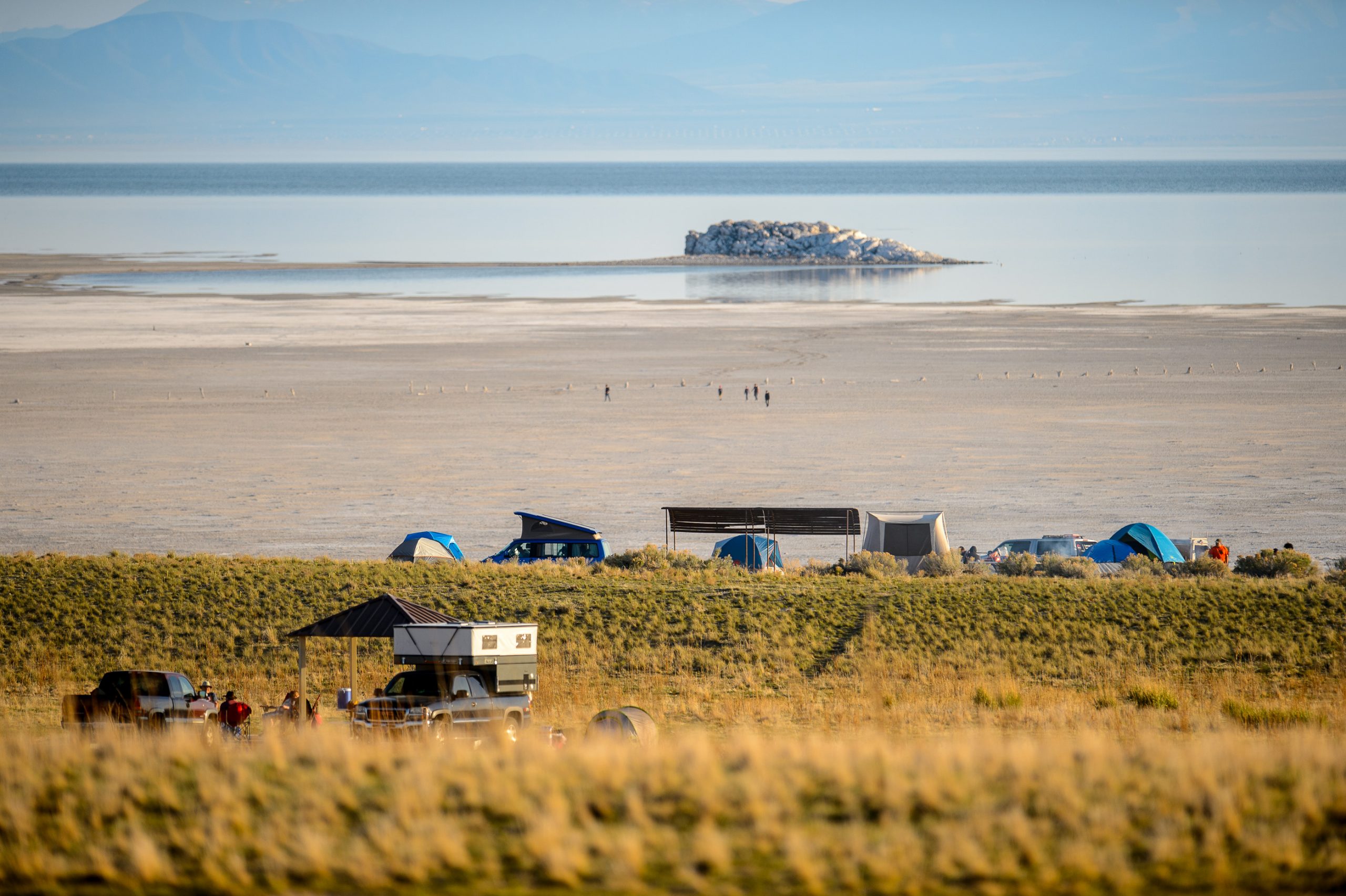(Francisco Kjolseth | The Salt Lake Tribune) The late afternoon sun ignites a rainbow during a brief rain shower in the Devils Garden campground at Arches National Park May 19, 2013.
Local News
How reserving campsites in Utah became a nightmare. And what you can do about it.
Published
5 years agoon
By Alicia Moore 
Editor

PROVO, Utah – For weeks Casey Gerbich had his eye on a choice campsite at Utah’s Bear Lake State Park for the week following the Pioneer Day holiday.
But all the planning in the world wouldn’t have helped him book a site through the state’s online reservation system, administered by the outside contractor Reserve America.
Gerbich discovered the hard way that the popular park allows many of its campsites to be booked ahead of time for family reunions.
“Every single waterfront and shaded spot is prebooked,” said a frustrated Gerbich, who lives in Wellsville. “They are prebooking the premier spots.”
He is hardly alone among Utah residents who have found it difficult, if not impossible, to book sites at Utah’s state parks. The competition is so fierce, you need to either cheat or get lucky to find a spot at the time you want, and many are frustrated with the online reservation system, which is easily gamed and offers limited customer service.
The state’s outdoor destinations were already being overrun before last year, but the pandemic made crowding more acute. Many more people now look to Utah’s mountains, deserts and lakes for safe places to recreate at a time when organized sports, amusement parks, concert venues, theaters and other popular recreation opportunities have been severely curtailed to minimize transmission.
Planning ahead
Until recently, state parks were Utah’s best kept secret, providing great opportunities to relax and explore the state’s scenic wonders off the well-worn paths in the “Mighty 5” national parks. The chances of finding a fall or spring camping getaway in Dead Horse Point, Snow Canyon or Goblin Valley state parks are now pretty slim unless you book four months in advance on ReserveAmerica.com.
You need to be logged in and ready to book at 8 a.m. on the day the booking window opens to get the site you want.
Visits to Utah’s 44 state parks skyrocketed last year by nearly a third, to 10.6 million. The parks’ campground bookings have also soared, from 95,000 in 2019 to 110,000 last year. The parks charge between $20 and $40 per night to camp and ReserveAmerica collects an $8 fee per reservation.
It’s a similar story in Idaho, where the Gem State’s 29 parks have also seen massive upticks in visitation, climbing nearly 22% last year to 7.7 million, according to Craig Quintana, spokesman for Idaho Department of Parks and Recreation. Camping reservations have likewise climbed, with 69,000 reservations booked through Reserve America last year.
Idaho uses a 9-month booking window at its parks, which are popular destinations for northern Utah residents, and charges a $10 reservation fee. Its cancellation and no-show policies are geared toward discouraging people from gaming the reservation system.
For example, a multi-day reservation will be cancelled if you don’t show up by checkout time on the day after your reservation starts.
For the Utah parks, you may book up to four months in advance. Because there is 14-day stay limit, people can book 13 days beyond the reservation window, then cancel the days they don’t need. Gaming the system in this manner is commonplace and it frustrates many as it unnecessarily blocks campsites for reservations.
Utah State Parks tries to discourage this practice, but the agency is at a loss for how to put an end to it.
“We we want people to follow the rules and play fairly. That’s our goal,” said Dave Harris, an associate director of the Utah Division of Parks and Recreation. “Before my time it was another process and people figured out how to get around that. So we went to a new process and now folks have figured out how to beat that system. So no matter what we do, someone is going to figure out how to game that system.”
No easy fixes
Officials recognize the reservation system has gotten frustrating and have tinkered with ways to address problems, but there are no easy fixes.
“Whenever we do something to rectify one complaint, it causes something that someone else doesn’t like,” said Harris.
Jessica Sweat’s family has been camping at Utah parks for decades and knows firsthand how much more difficult it is to book sites.
“Due to our state’s population and growing popularity, as well as people staying local for vacations, one has to take what they can get,” Sweat said. “Instead of convenience, booking policies lead to chaos.”
Her chief complaint is ReserveAmerica does not take adequate steps to thwart bots that can reserve sites the second they become available. She also faults the policy that allows people to book sites outside the reservation window.
“My family has lost campsites by seconds. This year, it took my family several days and multiple users trying to book in order to get a spot at our park of choice,” Sweat said. “We also kept encountering weird website errors that were not valid, such as ‘Inventory not available,’ despite listings showing availability.”
Sweat’s family rarely had a problem booking sites 20 years ago when you could call the park and speak directly with an actual human.
“I recognize the convenience of booking online, but there is a want for better customer service and experience,” she said.
Sweat suggested the parks set up a waitlist to assist campers in booking sites in the order they get inquires. This could ensure campers don’t have to constantly check back for cancellations; instead they could get a notification if their desired date comes available.
More inventory?
Help is on horizon in the guise of new and expanded state park campgrounds.
Under a bill the Legislature passed this year, state parks will add up 500 developed campsites at 15 existing parks. Additionally, two new state parks, Lost Creek in Morgan County and Utahraptor in Grand County, will be established in areas that already see heavy unregulated use.
“We’re spreading (new camping sites) all over the state where we’re encouraging people to go to deflect some of the use from the high-use areas,” Harris said.
Sites at Utah’s national park and national forest campgrounds can be booked through Recreation.gov up to six months in advance, though many federal campgrounds operate on an entirely or partially first-come, first-served basis. Generally, reservations are not required during the off-season.
(Trent Nelson | The Salt Lake Tribune) Campers at the White Rock Bay Campground of Antelope Island State Park on Friday, April 23, 2021.
The three campgrounds at Arches and Canyonlands national parks are among the most coveted in the state, if not the nation, and for good reason. Located in the midst of amazing redrock formations, they are full from March through October, according to Angie Richman, Arches’ chief of interpretation.
Canyonlands’ Island in the Sky campground holds only a dozen nonreservable sites and cannot be expanded because it lacks access to water.
One of the loops at the larger Needles campground is available on a first-come, first-served basis, while other sites must be reserved. If you show up in the Needles District and can’t find a place to camp, you might find a site just outside the park at the private Needles Outpost campground even at the busiest times, Richman said. Another nearby option is Hamburger Rock where the Bureau of Land Management operates a campground.
“There’s so many places to camp on nearby BLM land, there’s not a justification for us to build more sites, although the demand is there,” Richman said.
The BLM also uses Recreation.gov, but for group sites and river permits, not for individual sites. Its many Utah campgrounds are available only on a first-come, first-served basis, but the agency is looking into developing a reservation system, according to spokeswoman Rachel Wootton.
For those who don’t need developed facilities, there’s an endless array of options for dispersed camping on public land for free in some of the Utah’s most beautiful country, such as the San Rafael Swell, Gooseberry Mesa, the Grand Staircase and Big Flat. Be sure to bring a portable toilet and pack out all trash.
National forest camping
Utah’s five national forests offer at least 220 campgrounds, including dozens near population centers close to the Wasatch and Uinta ranges. Many are managed by a private concessionaire and can be reserved online at Recreation.gov. However, some of the best destinations, in quiet, scenic spots nestled next to streams and lakes cannot be reserved and are harder to get to. The Ashley National Forest’s 24-site Spirit Lake Campground in the eastern Uintas is an example of such a destination.
Bear Lake State Park’s 143-site campground, at Rendevous Beach on the lake’s southwest shore, has become a popular place for family reunions in recent years, presenting a unique set of management challenges. Since it is not practical for reunion organizers to book several contiguous sites through ReserveAmerica, the park allows them to book them far in advance through special-use permits administered directly by park staff.
To reduce conflicts with other campers, reunions should occupy neighboring campsites, according to Harris.
Otherwise “they’re going to be spread out all over the campground,” he said. “You’ve got these groups that are going to congregate on one site, grandma and grandpa’s site or mom and dad’s site, with kids running through other people’s campsites.”
To ensure sites are available through the normal reservation channel, such permits are not issued for five holiday weekends over summer, including Raspberry Days in early August. And no more than one-third of Bear Lake State Park’s campsites can be reserved for reunions at any one time.
Last year, Bear Lake issued 26 permits, but officials are going make it harder to get a permit by raising the minimum number sites required from five to 10.
While Bear Lake special-use permits make sense for park managers hoping to accommodate big gatherings, Casey Gerbich found the policy deeply frustrating because people trying to book a reservation have no way of knowing which sites have been blocked out until they attempt to reserve them.
That’s when you find out they aren’t available, he said.
And by then it’s likely too late to book a site that works for you.




